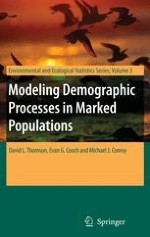2009 | OriginalPaper | Chapter
Comparison of Fixed Effect, Random Effect, and Hierarchical Bayes Estimators for Mark Recapture Data Using AD Model Builder
Authors : Mark N. Maunder, Hans J. Skaug, David A. Fournier, Simon D. Hoyle
Published in: Modeling Demographic Processes In Marked Populations
Publisher: Springer US
Activate our intelligent search to find suitable subject content or patents.
Select sections of text to find matching patents with Artificial Intelligence. powered by
Select sections of text to find additional relevant content using AI-assisted search. powered by
